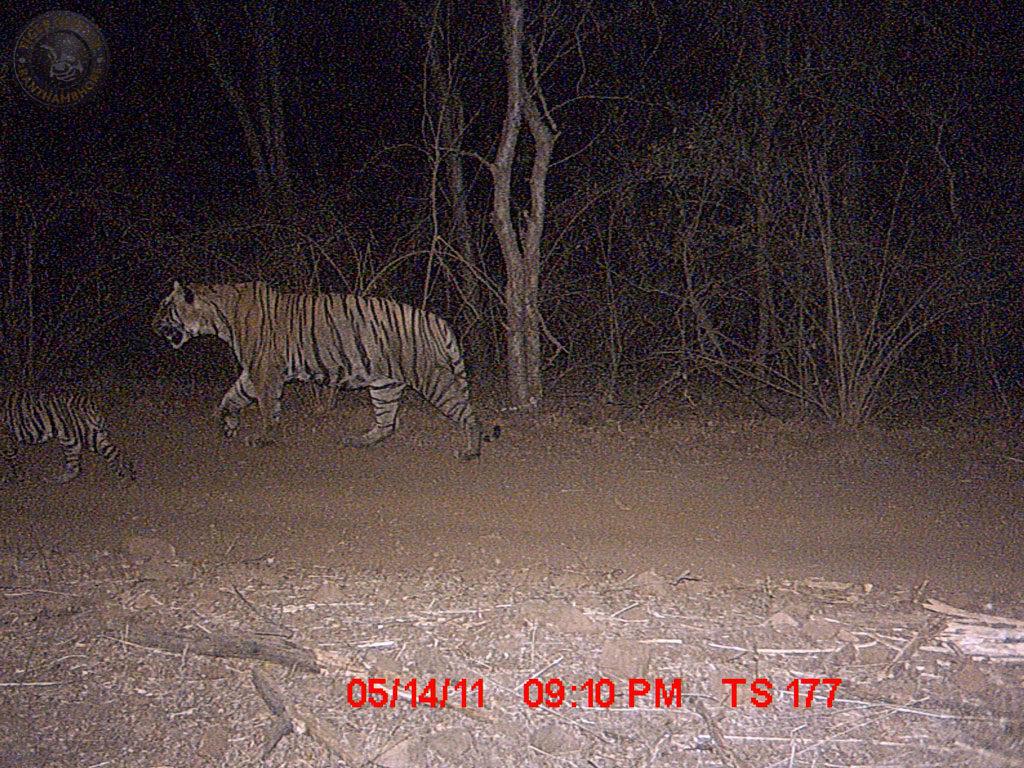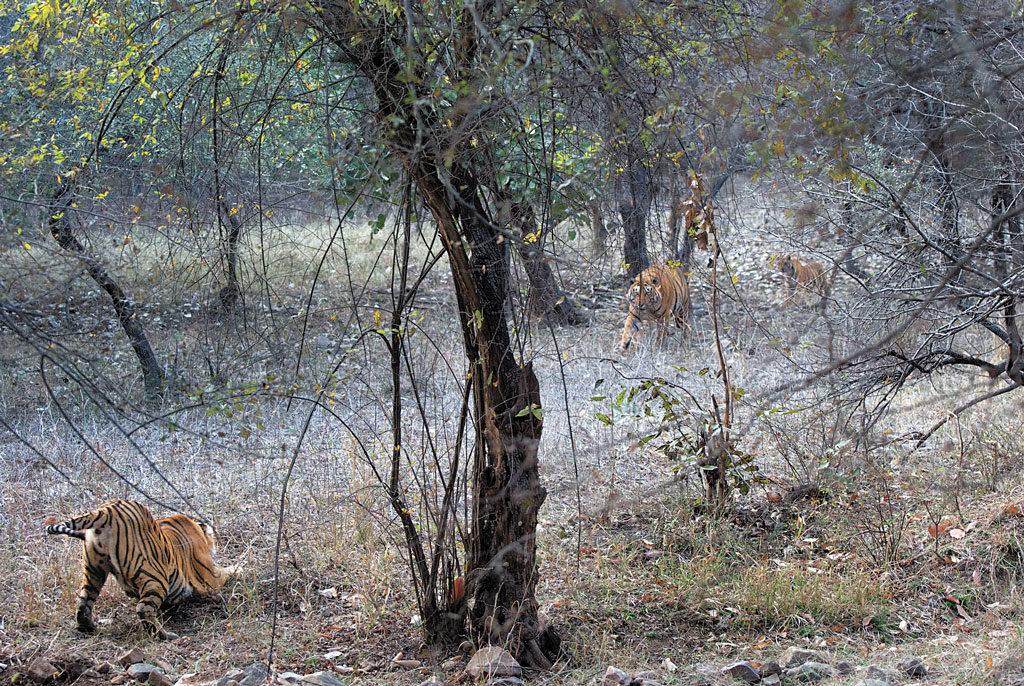In an unprecedented turn of events, the forest guards of Ranthambhore have attempted to raise orphaned tiger cubs in the wild, providing provisions and a semblance of security that was hitherto the responsibility of their mothers. Not only has this exercise over the last several years yielded unfamiliar facts about tiger behaviour, but also possibly saved these cubs from a wretched life of captivity!

Wednesday, February 9, 2011. At the crack of dawn, forest guards from the Kachida chowki collected their trekking gear and descended into the Kachida valley. The resident tigress, T-5, had been calling in pain all night long. With pounding hearts they ventured towards the dam and saw their worst fears come true. She was lying still on the rocks. A quick check confirmed that she was dead. T-5 had died of an illness, leaving behind two 3-month old cubs. Tiger cubs are extremely vulnerable and tiger mothers are thus very devoted. Tigresses dedicate two full years towards guarding and nurturing their cubs; they will even fight other tigers entering their territory and many a times get injured, sometimes fatally. This was the fourth instance in the last seven years when a tigress has died leaving behind cubs. Tiger cubs rely completely on their mothers to teach them the basics of hunting – stalking, outwitting their prey, and how to steer clear of potential dangers. Usually, the first impulse in such cases is to capture the cubs and transfer them to an enclosure to ensure their survival. But raising cubs in such proximity to humans would erode their ‘wild’ capabilities. However, in the four cases of orphaned cubs at Ranthambhore, the managers adopted an unprecedented strategy. The process was extremely difficult and full of challenges, but yielded some unique and striking observations on tiger behaviour. The effort of the staff of Ranthambhore in all these cases is definitely praiseworthy.

THE NEED OF A SAVIOUR
In tigresses, a pregnancy bulge is not visible because of a short gestation period (90 days). This is nature’s way of ensuring that the predator remains ‘hunting-fit’ and is not burdened by the extra weight. But this short gestation period also means that the cubs are delivered in a sort of underdeveloped state where some part of the development happens post delivery. In case of herbivores, like deer and antelopes, gestation period is longer as a pronounced pregnancy bulge does not hamper their lifestyle. But once they deliver, their fawns start walking within moments. In contrast, tiger cubs are born deaf (with their ear canals closed) and blind (eyelids tightly shut). Consequently, they are very vulnerable and totally dependent on their mother for everything. For the first month, a mother tiger devotes 70% of her time for nursing the cubs. During the span of 2 years for which the cubs stay with their mothers, this gradually reduces to 30%. Now imagine if such a dedicated mother were to die, leaving the helpless cubs behind. Ranthambhore has previously raised cubs to be ‘wild’. In 2002, an unexpected death of a tigress left two cubs orphaned. Instead of sending them to a zoo, the managers of Ranthambhore decided to rear them and take care of them in the wild. But in the absence of camera traps at the time, the management could not prove their success. In any case, this was the beginning of a new chapter in wildlife management. Now, with the availability of monitoring techniques and equipment, the efforts made for in-situ care of orphaned cubs were meticulously documented. The following four cases highlight the challenges, successes and new behavioural information that Ranthambhore’s unique experiments yielded.
QUALJI BROTHER AND SISTER
On September 1, 2008, tigress T-15 was found dead; it was very difficult to identify the reason as her body was decomposed. She left behind two cubs aged 7 months, a male (T-36) and a female (T-37). The cubs disappeared after this incident and despite intensive search efforts by the forest guards, there was no success. As a week passed by, the forest department started facing pressure from the media and tourism industry. Daulat Singh (ACF, Ranthambhore and one of the authors) learnt that tigress would also visit the Indala plateau sometimes with her cubs. The search was reorganised, and within hours, several pugmarks were found in the Indala area. A buffalo calf carcass was arranged as the cubs were too young to kill and camera trap images revealed that the two cubs came to feed on the carcass in the night. After spending a few days in Indala, the cubs returned to their mother’s favourite area. They survived on food substitutes given by the forest department.
However, after about 2 months, the cubs disappeared again, this time because of a young tigress, T-18, who came to occupy the vacant area. The department finally traced the male cub in the Lakarda area, which is in the central part of the park. After a few days the cub shifted further north to Anantpura. From the eastern part of the park he moved to the northern part. However, without the protection of a mother, he was once again pushed out, towards the western frontier of the park. The female cub, on the other hand, moved south. She reached the southern end of the park, towards the Chambal ravines, but returned and settled in the Jojheshwar area in Sawai Mansingh Sanctuary. On March 21, 2009, the male cub ventured into an agricultural field and was surrounded by people. Daulat Singh and his team rescued and released him in the Aantri area of Sawai Mansingh sanctuary, as the pugmarks of a female tiger were reported from here. Later he shifted to the Qualji area, which is connected to Aantri. In June, he came face to face with the resident tigress, which surprisingly turned out to be T-37! The brother and sister duo became the resident tigers of Sawai Mansingh sanctuary. Although there were speculations that the sub-adult tigers would leave during the monsoons, they stayed put and T-36 took over Qualji as his territory. By now, he was also fitted with a radio collar. In 2010, a male tiger, T-42, reached Qualji. Unfortunately, in the ensuing fight, on October 20, 2010, young T-36 lost his life at the age of 2 years and 9 months. Following his death, T-42 settled in Qualji with his sister T-37. The pair became very popular among tourists. T-42 continues to have a violent temperament, sometimes even charging tourist vehicles. On March 18, 2013, T-37 was reported to be ill and found dead by evening. The autopsy revealed that she had very high fat deposits and died of cardiac arrest. Though both cubs died tragically, they had reached adulthood, proving that with proper in-situ care, orphaned cubs could survive.
THE CUBS OF BERDA FOREST
On April 4, 2009, tigress T4 died leaving behind two cubs aged 17-18 months. This is a crucial age for cubs, as most of the learning happens during this age. Once again there was a male,T-40 and a female,T-41. With the experience taken from T-15’s cubs, the department was confident that they will be able to raise them. Ample water in the area and abundant prey in Berda area was a boon for the two cubs. In 2013, T-41 gave birth to a female cub. She is the first orphaned tiger recorded to have bred. The male, T-40 migrated out of the park and became untraceable post June 2010.

THE KACHIDA CUBS AND A FATHER FIGURE
Now back to the story we started with where T-5 had died leaving behind two 3-month old cubs. The initial impulse of the department was that the cubs were too young and it would be appropriate to capture and shift them to Sariska, where they would be reared in an enclosure. However, the cubs were untraceable for quite some time. Finally, a video camera trap got the footage of the cubs coming to a spot where there was food and water placed for them. They ate, drank and then disappeared. The park managers decided to raise the cubs insitu. Food, water and security of the cubs were the crucial elements in this exercise. The first two could be provided, but in a dense forest with several other wild animals, security could not be guaranteed. One day, pugmarks of the cubs and a male tiger were found together on the Kachida road. Camera trap images revealed the whole story, which opened up a new chapter in tiger behaviour study. The images showed a cub walking in front of the male tiger, T-25, who was followed by the second cub. This was an extraordinary find! The male tiger, whose territory the cubs were living in, was protecting them! The behaviour of T-25 drew attention to the important role male tigers play in ensuring the safety and wellbeing of their offspring, where it was hitherto thought that males do not have any role in the upbringing of cubs. The observations made during the rearing of B-1 and B-2 showed that this is not so simple. Social dynamics of tigers are complex and the role of a father is extremely important in the survival of the progeny. The challenge in providing substitute feed was to adapt it continuously to match the needs of the growing cubs, and also to ensure that it does not draw the attention of other predators. Thus the quantity and method varied from time to time. Starting with a dead, pre-opened goat to live prey, a lot of changes were made. While providing the substitute feed, the cubs were encouraged to develop their killing and hunting skills. In the beginning, the cubs were very clumsy. They could kill the prey only with great difficulty and in a very shoddy manner. There were times when the goat would attempt to attack the cubs. However, the cubs learnt fast and soon became adept at killing prey animals. During the course of rearing these cubs, it was observed that T-25 was even taking them to kills made by him and allowing them to feed. Since the territory was not occupied by any tigress, T-17, the tigress who lived around the lakes, started extending her territory, coming dangerously close to the area where the orphaned cubs were living. A video footage showed T-25, who was with the cubs at the time, threatening T-17 when she started stalking the cubs, clearly warning her to stay away from them. B-1 and B-2 were indeed lucky to have T-25 to guard them from other tigers. During the course of rearing the cubs, there was an instance when they disappeared for 10 days. Searching the places where they were earlier seen, with and without T-25, yielded no positive results. Then one day, a guard informed the officers that he had seen something moving up a hill. When the search party climbed about halfway up, they discovered an extraordinary location. Between two rocks, there was a deep crevice forming a cave. It was so narrow that only the cubs could walk into it. At the lower opening of the crevice, there was a semicircular platform. The cubs were staying in this crevice, coming out and chasing each other on the platform. Near the crevice, there was an overhanging rock, and a stream trickled and filled a bowl with water even during the peak summers. How the cubs discovered this superb home is a mystery. In subsequent days, camera traps revealed that a pair of leopards would also visit this place. It is difficult to imagine how the cubs would have dealt with such visits, as nothing caught on the camera traps gave much of an indication. As the cubs grew, they were gradually and very carefully weaned off of substitute prey. Gradually, they started hunting wild prey on their own. However, there was constant pressure from T-17, who was growing intolerant towards these cubs. As a result, the cubs made their home on the periphery of the park. They even divided the peripheral area into two territories, with a common area in between where they would meet and spend time together often. Since they could have come into conflict with the humans living near the periphery of the park, it was decided to shift them to Sariska. They were relocated in the winter of 2013. Recently, one of them has even given birth to cubs, adding five-stars to this success story.
THE LADY OF THE LAKES AND HER THREE CUBS T-17
The Lady of the Lakes had given birth to three cubs near Rajbagh lake. When the rains came and she had to shift the cubs, she left the lakeside territory and fled to the fringe area beyond Kachida, to a place called Badlao. In the winter of 2013 she was found injured badly in a fight with some other tiger. She was tranquilised and treated; her wounds were deep and infested with maggots. She was also given substitute prey so she could avoid stressing her injured forelimbs by attempting to hunt again. However, the very next day, she was found fighting with T-25. The pressure to fulfil the requirements of three growing cubs was proving difficult for the first-time mother. In April 2013, she went missing, leaving three 10-month old cubs – 2 males and one female, in the Badlao area. Incidentally, these cubs are also in the same area as the cubs of T-5. So many enthusiasts expected that they would be adopted by T-25 too. Even though they were not seen with him like B-1 and B-2 were, it was apparent that T-25 had provided the umbrella of security to these orphaned cubs and they are now being reared in-situ. A forest employee reported that on one occasion he saw T-25 sitting with the female cub, while the two male cubs were not far away. These cubs are now over two years old. The future of orphaned cubs in the wild is unpredictable. Without the mother, their guardian angel, the wilderness can be a harsh place for vulnerable and helpless cubs. All other animals are their enemies, and other tigers are the biggest threat. But even in this hopeless situation, human effort and their own destinies seem to be on the side of the orphaned cubs of Ranthambhore.
Divya Khandal and Dharmendra Khandal

